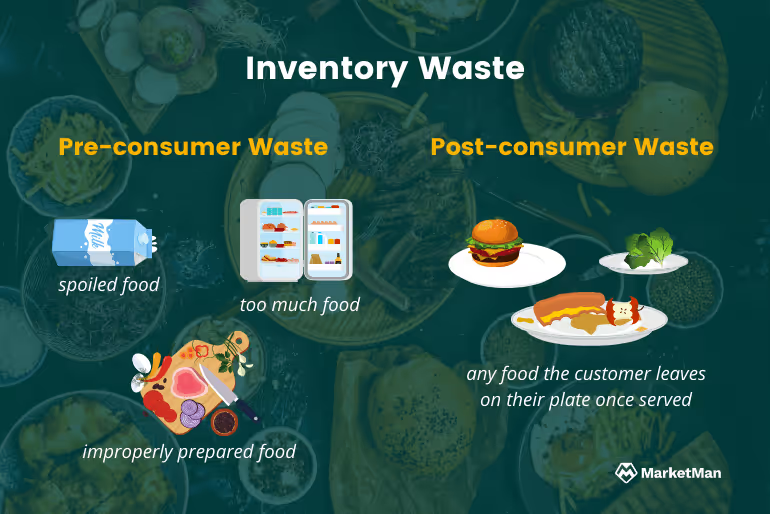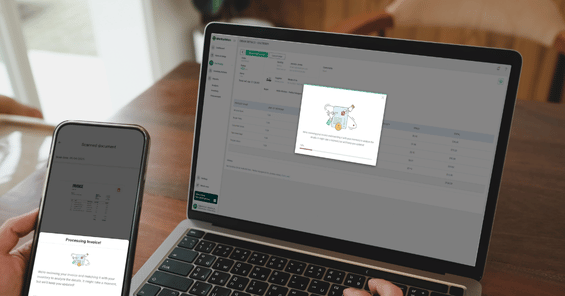

Reducing Restaurant Inventory Waste: The Essential Guide to Maximizing Your Profit Margins
How should you keep track of inventory waste in your restaurant? You need to figure out where your waste is coming from, diligently maintain waste sheets, calculate your inventory turnover ratio, and create schedules for inventory checks.
Inventory waste is the biggest reason why restaurants lose money. It can be categorized in two ways: pre-consumer waste (spoiled food, too much food, or improperly prepared food) and post-consumer waste (any food the customer leaves on their plate once served). Restaurateurs can't control the latter, but they can control how much inventory is wasted before food leaves the kitchen. On top of the social and environmental benefits of reducing inventory waste, controlling waste is the best way for your restaurant to improve margins and increase profitability. In this article, you will learn:
- The definition of inventory waste
- Where waste comes from
- How to record waste
- How to set inventory schedules
Six Foolproof Restaurant Cost Management Techniques
Maximize your restaurant's profitability with this essential eBook. 📈 Learn foolproof cost management techniques and unlock proven strategies for supplier negotiations and brand loyalty. 👩🍳🤝

What Is Inventory Waste?
Inventory waste is any inventory in your restaurant that is disposed of instead of sold to a customer. Here’s an example of inventory waste. You decide to take the soy milk latte off of your menu. However, you're so busy that you forget to remove the soy milk from your next delivery order. The soy milk that you receive is now useless, and you have to throw it away. If you’re not taking thorough inventory, you might:
- Order too much of an ingredient that you won't use before it spoils
- Miss expiration dates on items that could have been used in specials before they expired
- Fail to recognize when your new cooks are over-portioning ingredients
A simple way to see where waste is occurring in your restaurant is to run your CoGS and usage reports after taking an inventory count. Restaurant inventory management solutions are your best bet when it comes to staying on top of inventory tracking. These platforms help you strategize what items to order to cut down on waste while allowing you to control your budget and spending. It’s also important to know the price of each ingredient from your suppliers. These variable costs fluctuate with every order, so keeping tabs on prices is key to understanding how much waste is costing your restaurant.

Where Does Inventory Waste Come From?
Here's a brief overview of where waste can show up in your restaurant.
1. Food Spoilage
Spoilage refers to ingredients that expired and are spoiled on shelves. Abnormal waste and spoilage can also occur due to improper storage, over-supply, equipment malfunction, or poor-quality ingredients.
2. Customer Plates
Portion sizes have increased across the country and often end up as product loss. Restaurant customers in the US leave 17% of their meals unfinished on average. One way to avoid half-finished plates is to offer customers takeout containers for leftovers.
3. Food Preparation
A large amount of waste at restaurants comes from the back-of-house during shift prep work. Over-preparation of food, inaccurate chopping techniques, lack of proper tools or equipment, and sending out incorrect orders all contribute to this. Minimize losses by properly training your staff to create dishes efficiently, measure ingredients, and avoid wasting anything
4. Shrinkage
Shrinkage is the difference between the amount of food available and the portion you can use. For example, you can lose product by peeling, trimming, or coring a piece of produce. Theft can also lead to inventory shrinkage.
Maintain A Sheet For Waste And Inventory Errors
Much of a restaurant's inventory has a relatively short shelf life. That means mitigating waste is a top priority for restauranteurs. To understand waste, you need to document it. Consider starting a food waste inventory sheet that shows where waste is occurring. Your back-of-house kitchen staff can be critical in this process, writing down spillage, errors, and spoilage as they occur. A waste sheet will show you where inventory is going that is not being accounted for by sales. This sheet allows you to come up with solutions for wasted food items. For example, if your sheet shows that many ingredients spoil, you can purchase less or find new ways to use the items. Or, if dishes are consistently deemed incorrect by the customer, servers may need to pay more attention when putting orders in your system. Your POS or restaurant management system may include a place for this type of sheet and allow you to input information digitally. You can also make a waste sheet with the following columns:
- Time and Date
- Item
- Amount or Weight
- Reason for Waste
- Employee Initials
Ensure that every team member understands the waste sheet and uses it to provide updates as necessary. Currently, the National Restaurant Association reports that only 47% of restaurants track their waste, leading to lost revenue, increased operating costs, and a more considerable environmental impact. Creating a record sheet specifically for inventory waste will show you everything your inventory list doesn't. You'll gain insight into ways to save money and stock when you know how much waste your kitchen produces over time.
Set Up A Schedule To Check Inventory And Avoid Waste
You're undoubtedly juggling different priorities when running a restaurant, so scheduling regular inventory checks are essential to ensure it gets done. Once you have a process in place with your team, decide when you will do inventory. Be sure to do inventory counts before you place new orders, so you don’t waste money on products you already have, which leads to waste. Scheduling inventory checks regularly allows you to see how much stock is used in a specific period. With frequent tracking, you can start to spot trends, and you are in a better place to investigate irregularities. With regular checks, you can easily view aberrations in your finances that may indicate that you need to update portion control standards, order less of an ingredient, or do additional staff training. We recommend automating the inventory process fully. The right tech solution can provide insightful data into how you’re performing financially. You can use them to calculate food cost percentage, figure out your least and most profitable items, and reduce over-buying. You’ll get automated reports on inventory that goes out, such as menu items and ingredients sold and waste produced. This technology keeps you up to date on daily waste production, so you can create actionable strategies to decrease it.

MarketMan's restaurant inventory management software is designed to automate inventory control, reduce food costs, and optimize all back-of-house activities. By eliminating manual processes, MarketMan empowers restaurateurs to work smarter, reduce waste, and gain insights for improved profitability. Take the guesswork out of restaurant management—book a demo today to experience how MarketMan can elevate your operations!
Author
Contributors
If you have any questions or need help, feel free to reach out
Don't miss out on maximizing your restaurant's profits! Calculate your ROI with MarketMan
Join over 18,000 restaurants and get the hottest restaurant tips delivered to your inbox
You may also be interested in
Ready to get started?
Talk to a restaurant expert today and learn how MarketMan can help your business






